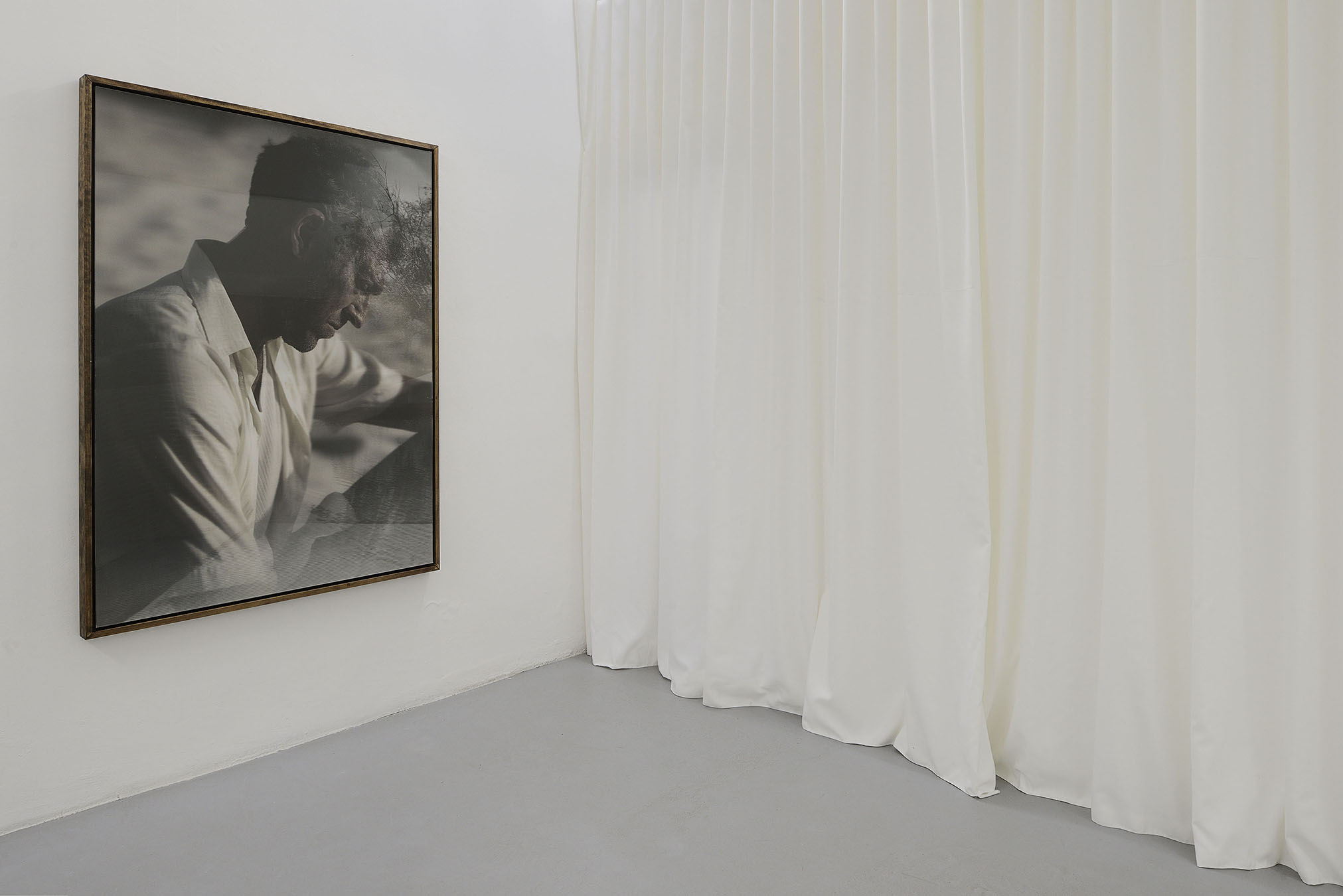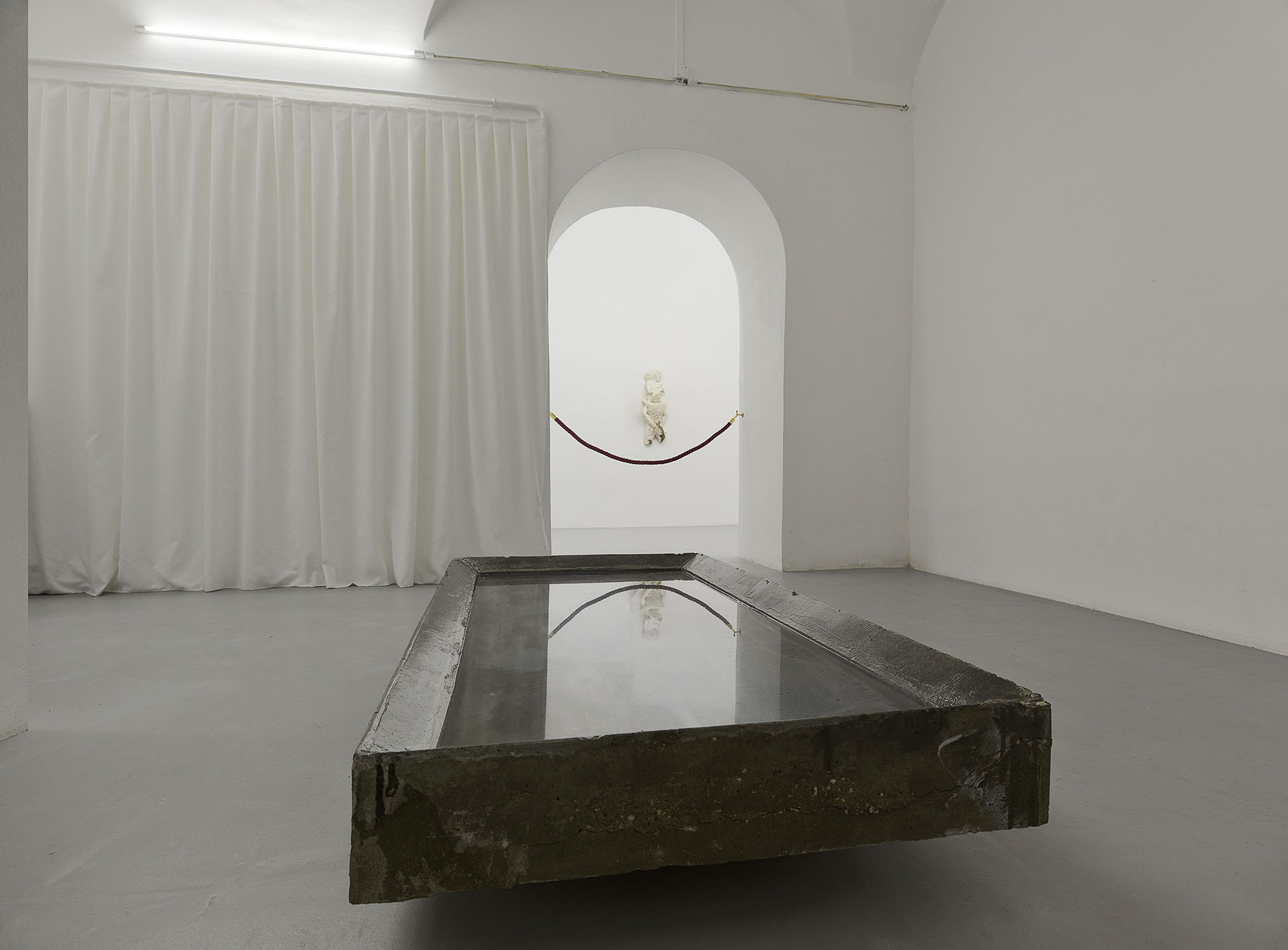Yves Scherer
Les Bains Douches
Basement Roma
May 29 — July 19, 2019
For years, Swiss artist Yves Scherer (b. in 1987, lives and works in New York City) has made celebrity culture the subject of his artistic practice. But where his work used to focus on individual stardom and the obsession of the public eye with on one particular being, this scope has shifted. In his latest body of work, an interest with a broader universal truth has surfaced: the human condition revisited through the defragmentation of celebrity culture.
It is a contemporary triptych that greets the visitor of Yves Scherer’s latest show Les Bains Douches at Basement Roma. A small basin, filled with water, a photographed portrait intersecting with architectural imagery, two deeply intertwined figures, cast in plaster. The two bodies, melted together in white plaster, show cracks within their surface. While they clearly bear resemblance to classical sculpture per se, it is the imperfection and the fragility of their natural state that immediately touches the viewer’s gaze. The male body rests on the abdominal region of the female figure, holding on to her in an almost child-like state, while she gently caresses his head. Where the original image of this encounter depicted Kate Moss and Johnny Depp in a photograph by Annie Leibovitz, Scherer’s sculpture has lost this direct reference. Transforming into a different medium and body the Pygmalion-like idealization has become a more universal image of the most primal and ideal state of a relationship. Obsolete of social norms and convictions –such as male dominance and female submission– the artwork has been stripped down to the most basic interpersonal needs for love and care-taking.
On the picture on the wall, a man is faced sideways, a photograph lenticularly layered with the modernist architecture of a house and pool.
His likeness is the one of French actor Vincent Cassel, a charismatic man, who certainly portrays archetypical features: he seems strong, attractive, manly. Yet, his expression is pensive. It is a similar effect that we have witnessed before. Through Scherer’s lens, Cassel’s idealized image as a celebrity, that was devoid of any real and profound context to begin with, has become obsolete. Instead, the picture offers the interpretation of being a much broader comment towards manhood. While society has undergone an upheaval in regards to the standardized roles of men and women within the past twenty years, the individual male finds himself recalibrating his own place within society. The archetypical role is still demanded, yet it remains unclear, in what way. Scherer takes this intrinsic conflict, often witnessed within society today, and creates a correspondence within the two layers of the photograph. The architecture behind Cassel’s face is a depiction of the work of Mexican architect Luis Barrágan. Barrágan’s style has often been referred to as ‘emotional architecture,’ since it opposes the pure functionalism of architecture, thus challenging an archetypical view of modernism. Barrágan would often incorporate water as a counterpoint to the straight lines and edges of his colourful, modernist structures and the raw materials of his work, such as stone or wood.
It is exactly this interplay of lightness and gravity, of form and function, of archetypical and emotional states of existence, which occupy Yves Scherer’s practice and find their translation in the artwork’s context as well as in its formalistic aspects.
On the floor of the exhibition space, a water basin introduces this multi-layered interplay three-dimensionally. Functioning as a physical counterpart to the impalpable emotions and social notions within Scherer’s work, the basin formalistically opposes the cast’s gravitas with lightness and the state of flux, immanent to water at all times. The form of the bath also references the language of swiss mountain cattle trows while at the same time opposing this autobiographical notion in an alternative interpretation as an infinity pool. Again, a more archaic type meets contemporary culture. It is this clash, brought into form, which links towards the exhibition’s title, that draws inspiration from yet another beacon of celebrity culture.
Nowadays known as a legendary nightclub, the Les Bains Douches opened its doors in 1978 and marked the golden age of Paris nightlife. The club quickly became a temple for night culture and a place of freedom with an illustrious crowd. Mingling by and in the mosaic tile pool, partygoers and creatives celebrated amongst the likes of Jean-Michel Basquiat, Yves Saint Laurent, Mick Jagger, Johnny Depp and Kate Moss. But even though the vibe of the night club was certainly glamorous, it was not slick. An aspect, which again speaks to the interplay of oppositions within Yves Scherer’s work. It is the juxtaposition of the world of celebrities and glamour, next to the raw architecture of the former baths with its utilitarian identity, that finds its equivalent within the counterposition of forms and context in his show at Basement Roma. The artist incorporates the superficiality of glamour, the fleeting state of joy within the ethereal purity of his whitened exhibition space that at the same time remains a basement, with an underlying griminess it can never dispense of entirely.
In his survey of the individual’s state of being through the defragmentation of celebrity culture, Scherer discovers a collective sentiment within modern day culture, that reveals the individual longing for more existential profoundness in a rapidly changing society.
Text by Anneli Botz
All Images:
Courtesy the artist
Photos by Roberto Apa










